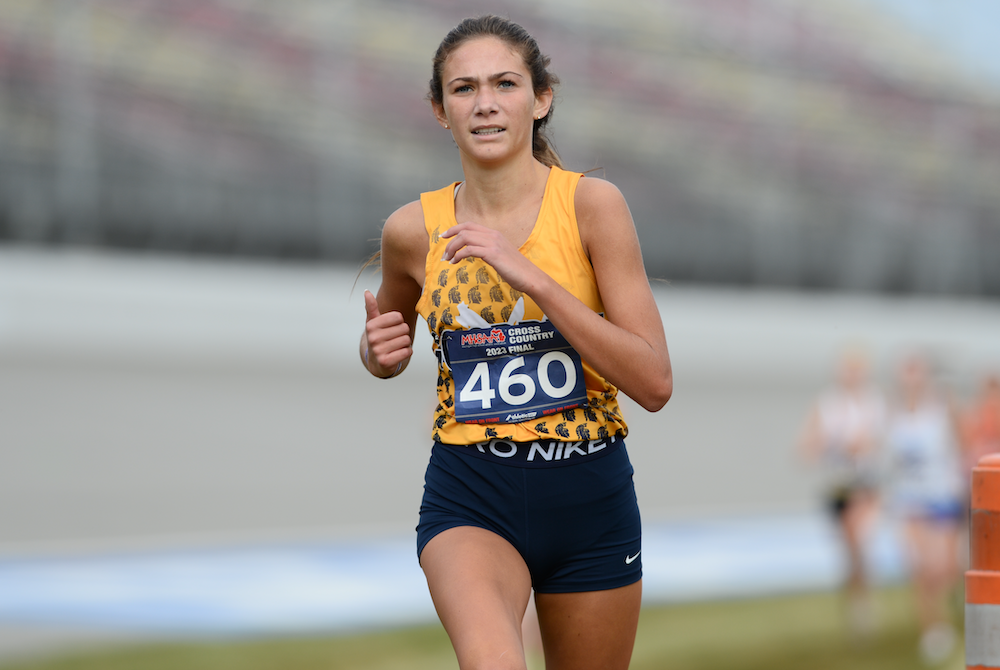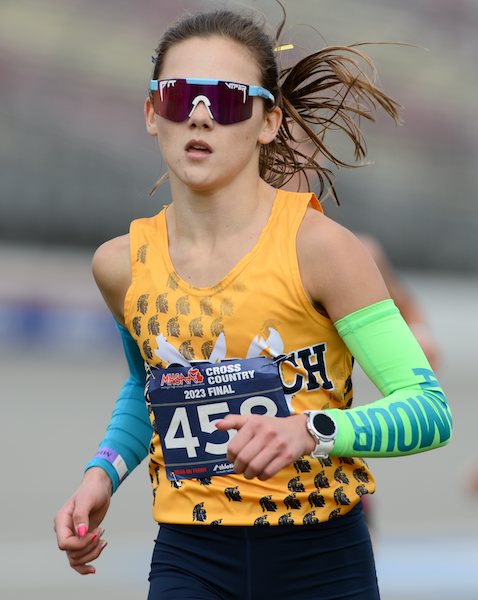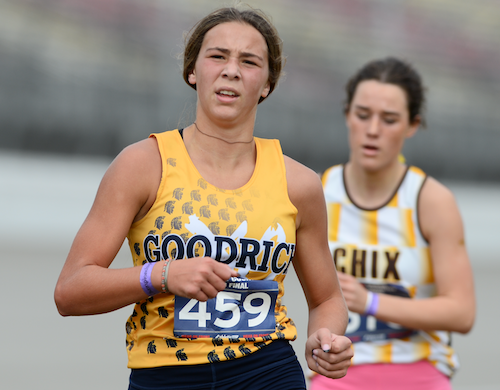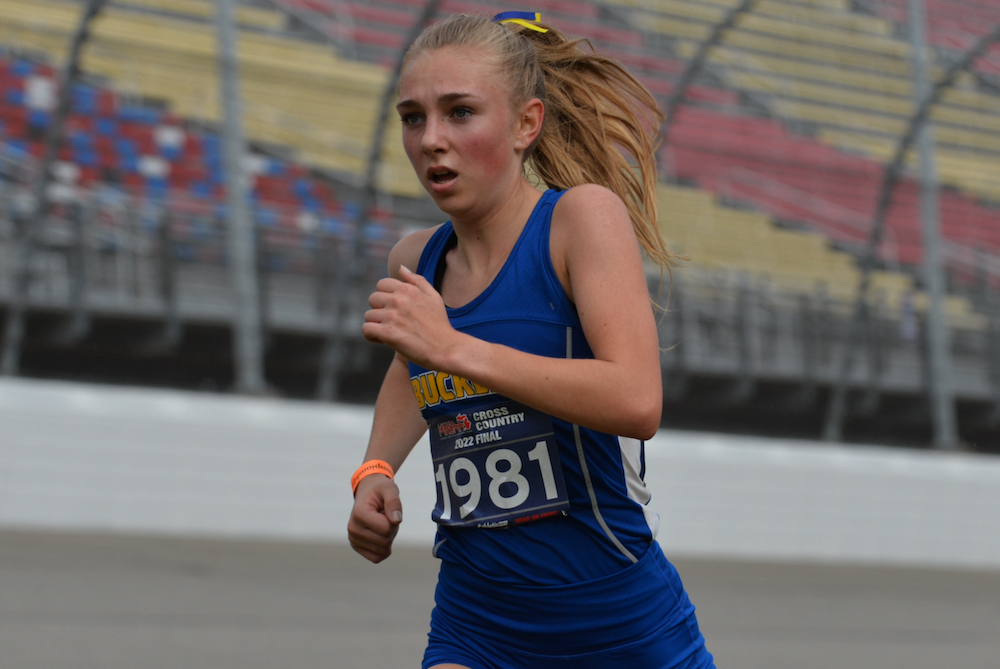
Goodrich Enjoying Every Moment of Pursuing 1st Finals Title since 2005
By
Paul Costanzo
Special for MHSAA.com
August 23, 2024
Kamryn Lauinger and her Goodrich girls cross country teammates have a very big but attainable goal heading into the season: Stand atop the podium as Division 2 Finals champions at Michigan International Speedway on Nov. 2.
 The Martians were third a year ago, return their entire top seven, and added a top-flight freshman to that already stacked lineup.
The Martians were third a year ago, return their entire top seven, and added a top-flight freshman to that already stacked lineup.
But you won’t catch Lauinger and the Martians looking ahead; they’re too busy enjoying every moment together along the way.
“I don’t want the season to go by fast,” said Lauinger, who placed 10th at the 2023 Finals. “It’s my last year, and we’re all kind of taking it all in, working hard together and preparing for what we can accomplish.”
Goodrich entered the season as the top-ranked team in Lower Peninsula Division 2, and with one meet under its belt has lived up to that ranking. The Martians won the Unionville-Sebewaing Invitational on Aug. 19 with a perfect score (15) – 1. Lauinger; 2. Jordan; 3. Sophomore Alivia Ottinger; 4. Sophomore Claire Brown; 5. Senior Avery Byrne.
Their sixth (freshman Kayla Shellenbarger) and seventh (sophomore Baylor Lauinger) runners finished sixth and seventh.
 “It’s definitely exciting – I think we’re going to have a really great season,” said senior Layla Jordan, the reigning LP Division 2 Track & Field 800-meter champion. “Also, at the same time, we’re taking the same approach. We’re not changing anything we do. We’re excited, but we’re trying not to get too excited to the point where we look ahead. It’s really great to know that we have such great depth. Everybody is working for the same goal, and we all can just rely on one another.”
“It’s definitely exciting – I think we’re going to have a really great season,” said senior Layla Jordan, the reigning LP Division 2 Track & Field 800-meter champion. “Also, at the same time, we’re taking the same approach. We’re not changing anything we do. We’re excited, but we’re trying not to get too excited to the point where we look ahead. It’s really great to know that we have such great depth. Everybody is working for the same goal, and we all can just rely on one another.”
They’re also relying on their self-described “computer geek” of a coach, Al Warden, who has built a season-long plan he said is backed by science and computer programs – along with his own knowledge.
“I tell the kids all the time, this is not about going out there and being faster than everybody else,” Warden said. “You have to be smarter than everybody else. It’s science-based. Every single practice is science-based.”
Warden creates his training calendar by starting at Nov. 2 and building backward. That includes more than just workouts, as one of the items on next week’s agenda is buying new shoes.
“The more determined runners, they’re at that 400-mile mark,” he said. “They need new shoes, because they wore them out. That’s right in my schedule so I don’t have to remember to remember it.”
Warden’s plans are clearly getting results, and his runners have bought in completely.
“It definitely helps, because we know he cares,” Lauinger said. “I do like knowing all of his science – he does a lot of research. I like it. I like how he does it.”
While Warden is focused on the science of training, he hasn’t forgotten that it also needs to be fun if he’s going to get the most out of his runners.
So, mixed in with the temple runs and 10-mile days around Top Hill Farm are donut runs, slushie runs, pizza parties and swimming parties. There’s also a “no runner left behind” policy that ensures the top runners turn back and finish with the next group, reinforcing a culture of togetherness.
 “I think it’s just that we all enjoy it,” Jordan said. “You have to love what you do, and we all love running. It’s really cool to be great at something, but it’s not as fun to be great alone. We all want to be great.”
“I think it’s just that we all enjoy it,” Jordan said. “You have to love what you do, and we all love running. It’s really cool to be great at something, but it’s not as fun to be great alone. We all want to be great.”
If the Martians were to finish off the season with a Finals title, it would be the first since they won three straight from 2003-05.
As Warden said, “it’s time for Goodrich to win it again.”
His runners agreed.
“It would mean to me that I got to do something that’s going to be long-lasting,” Kamryn Lauinger said. “To have the little runners at Goodrich looking up to us. Just to have something long-lasting and people knowing that I came in here and did what I needed to do and left a mark.”
A Finals title would also allow the Martians to partake in one of their favorite traditions – treating a championship trophy like the Stanley Cup, and allowing a team member to take it home with them.
Who gets each trophy is normally a pretty easy decision, Jordan said, as they’re often on the same page about who deserves it on a given day.
There would be absolutely no debate if they win the big one: Warden.
“He’s the reason that we’re up there anyway,” Jordan said. “We couldn’t have done it without him.”
 Paul Costanzo served as a sportswriter at The Port Huron Times Herald from 2006-15, including three years as lead sportswriter, and prior to that as sports editor at the Hillsdale Daily News from 2005-06. He can be reached at [email protected] with story ideas for Genesee, Lapeer, St. Clair, Sanilac, Huron, Tuscola, Saginaw, Bay, Arenac, Midland and Gladwin counties.
Paul Costanzo served as a sportswriter at The Port Huron Times Herald from 2006-15, including three years as lead sportswriter, and prior to that as sports editor at the Hillsdale Daily News from 2005-06. He can be reached at [email protected] with story ideas for Genesee, Lapeer, St. Clair, Sanilac, Huron, Tuscola, Saginaw, Bay, Arenac, Midland and Gladwin counties.
PHOTOS (Top) Goodrich’s Kamryn Lauinger pushes through the final stretch to finish 10th at last year’s LPD2 championship race at MIS. (Middle) Layla Jordan races for the finish line in placing 27th last season. (Below) The Martians’ Baylor Lauinger and Zeeland East’s Meredith Cook charge toward the finish. (Click for more from RunMichigan.com.)

Buckley's Harrand, Johannesburg-Lewiston Complete 1st-Time Champions Sweep
November 5, 2022
BROOKLYN – People in Aiden Harrand’s support system saw potential in her before she saw it in herself.
She was having a strong start to her freshman year at Buckley two years ago, but Harrand had no idea how good she could become.
Other people around her could see the greatness within her, however.
“My freshman year, I had all the people around me kind of saying, ‘You could win the state meet your freshman year,’” Harrand said. “I didn’t really believe it. Well, I started looking at the rankings and stuff, and I really could. But I had a rough morning that year. It didn’t turn out like I wanted. It lit something inside me like, ‘I want to get this done. I want this to be my main goal.’”
It took two years, but Harrand has fulfilled the promise that her coaches and teammates forecasted for her. She won the MHSAA Lower Peninsula Division 4 championship Saturday with a time of 19:05.89 on a wind-swept Michigan International Speedway course.
Harrand was a contender her first two years, placing fifth as a freshman and second last year.
This year, everything came together.
 “Both years, I was ranked 1 and 2 for both of them,” she said. “I didn’t quite get there. This year, I was able to do it.”
“Both years, I was ranked 1 and 2 for both of them,” she said. “I didn’t quite get there. This year, I was able to do it.”
Getting her training plan and nutrition dialed in helped Harrand achieve her goal. So did showing up at MIS as the member of a qualifying team after racing her first two years as an individual qualifier.
“Mentally, it feels a lot better having a team, because you’re not only running for yourself, but you’re running for the people with you,” she said. “It just feels better.”
Harrand won 11 of her 12 races this year, finishing second at the Sparta Invitational to Kent City sophomore Lila Volkers, who was fifth in the Division 3 race.
Harrand won her Regional meet with a season-best time of 18:11, but MIS wasn’t going to yield personal records Saturday.
“I wish it went a little faster, but because of the wind and the weather, it was kind of hard to push through it,” she said. “It’s always crazy here.”
Johannesburg-Lewiston won its first team championship, scoring 118 points to beat last year’s program-best sixth-place finish. Hillsdale Academy was second with 151 and Whitmore Lake was third with 192.
Sophomore Allie Nowak was third in 19:20.80, freshman Yolanda Gascho was seventh in 20:04.18, junior Madalyn Agren was 49th in 21:17.05, senior Adelaida Gascho was 54th in 21:26.87 and junior Rosalinda Gascho was 58th in 21:32.23 for Johannesburg-Lewiston.
PHOTOS (Top) Buckley’s Aiden Harrand pushes toward the finish line at MIS on Saturday. (Middle) Allie Nowak runs third for Johannesburg-Lewiston in leading the first-time team champion’s placers. (Click for more from Dave McCauley/RunMichigan.com.)

